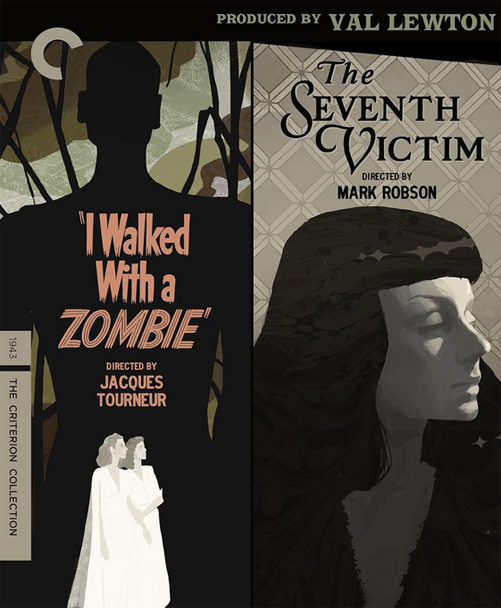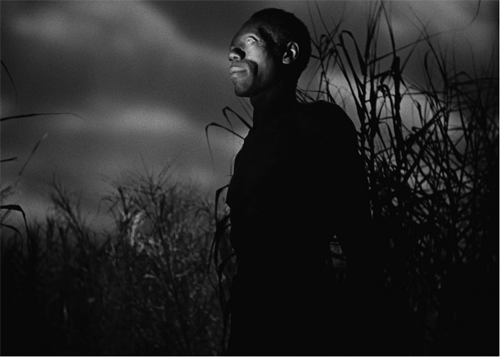
“A
VAL LEWTON HI-DEF DOUBLE FEATURE”
By
Raymond Benson
Most
folks who pay attention to Cinema Retro will likely know who Val Lewton
is. For those who don’t… After Orson Welles made Citizen Kane and The
Magnificent Ambersons at RKO Radio Pictures and (unwittingly and
undeservedly) nearly destroyed the studio, the top brass needed some quick
influx of money. They hired producer Val Lewton to “do what Universal was doing
and make some horror movies because that genre was profitable!” The only
problem was that they gave him practically nothing in terms of a budget to make
these films. It was up to Lewton to decide the kind of pictures he would make,
who to hire to make them, and so on.
Thus,
between 1942 and 1946, with Lewton at the producing helm, RKO released a string
of remarkable low-budget frighteners that relied not on expensive makeup or
visual effects to scare the audience, but rather carefully executed black and
white cinematography, sound, and storylines that left the horror in the
viewers’ imaginations. It was the adage—what you don’t see is likely creepier
than what you do. And it worked.
Lewton
hired talented filmmakers who drew upon German expressionism (and this was the
same time that Hollywood was beginning to make low budget crime dramas, later
known after the fact as film noir, using the same visual techniques) to
create an eerie atmosphere of contrasting dark shadows and light. Add in some
spooky sounds (wind, creaking doors, cat screeches, metal garbage cans crashing
loudly on a sidewalk) and a sensibility that anything could be lurking
around the corner… and you have some truly unnerving motion pictures. We don’t
need no stinkin’ monsters!
As
illustrated by film historian Imogen Sara Smith in an excellent supplement
about the Val Lewton film series, another aspect that made the films creepy was
an overwhelming sense of dread and death in all of them. They were nihilistic
explorations into the dark abscesses of the human soul. Suicide, murder, depression,
and repressed sexuality were common themes in all the titles.
First
out of the gate was Cat People (1942, also available on the Criterion
Collection), which was a surprise box office hit. French director Jacques
Tourneur and cinematographer Nicholas Musuraca established the style and
presentation of the Lewton movies with sensitive, canny direction and film
noir photography.
I
Walked with a Zombie
(1943) was next, and it’s this reviewer’s favorite among all the Lewton titles.
Loosely inspired by Jane Eyre, it’s one of the earliest Hollywood movies
to deal with voodoo in the West Indies. Tourneur also directed, but with J. Roy
Hunt as DP. Starring Frances Dee as Betsy, an innocent nurse on a Caribbean
island who is hired to care for Jessica (Christine Gordon), the invalid wife of
Paul (Tom Conway), a sugar plantation owner. Jessica is near catatonic but
wanders silently outdoors at night. Betsy soon learns more about the island’s superstitious
beliefs in Vodou and is surprised that even Paul’s mother, Mrs. Rand (Edith
Barrett) is a practitioner. It isn’t long before Betsy, who has fallen in love
with her employer, encounters the underbelly of the Vodou community and must
protect herself and her charge.
Is
I Walked with a Zombie “scary”? Well, no, not really, not any more than
any of the Lewton horror films. But what it has going for it is style and
atmosphere in spades. This is one of the most poetic horror films ever
made. It’s a beautifully-rendered, impressionistic tale that is creepy, to be
sure, and somewhat shocking (certainly for its time). There is much more happening
here than a mere zombie story. The themes of slavery and racism also crop up to
make the picture a much more meaningful treatise on the voodoo concept. And it
is absolutely gorgeous to look at.

The
Seventh Victim (1943)
was the fourth Lewton-produced picture, this time directed by Mark Robson, who
had been the editor on the first three Lewton titles. Nicholas Musuraca is back
as cinematographer, and the pictures would not have been as effective without
him. Something of a precursor to Rosemary’s Baby (1968), The Seventh
Victim is about a devil-worshipping cult in New York City’s Greenwich
Village. Mary (Kim Hunter, in her first film role) is a young student looking
for her missing older sister, Jacqueline (Jean Brooks). Her investigation
introduces her to Gregory (Hugh Beaumont), who is, surprisingly, married to
Jacqueline, Dr. Judd (Tom Conway again), a psychiatrist who had been treating
Jacqueline, and poet Jason (Erford Gage), who offers to help in the search.
Mary eventually finds the despondent Jacqueline, who expresses the desire to
commit suicide. It turns out she is under the influence of the
Satan-worshippers, who believe that traitors to their cabal should die
preferably by suicide rather than violence.
Apparently,
The Seventh Victim went through a drastic post-production phase in which
at least four big scenes were deleted. As a result, the storyline in the
picture is often incoherent. We can’t help but wonder what the heck is really
going on most of the time. But is it “scary”? Again, no, not really, but the
film is indeed atmospheric, beautiful to look at, and has a sense of anxiety
that keeps one interested until we reach an ending that is, unfortunately,
unsatisfying. Nevertheless, Victim tackles unusual themes (watch for the
hint of a lesbian relationship between Jacqueline and her best friend, played
by Isabel Jewell). It’s a wonder that The Seventh Victim got through the
Hays Office with the Production Code seal of approval, considering its unsavory
set of villains and a suicide plot.
The
Criterion Collection has released a 4K/UHD edition and a Blu-ray edition of
both films on a single disk (the 4K/UHD edition includes the Blu-ray disk,
which also sports the supplements). The disk features a 4K digital restoration
of both films with uncompressed monaural soundtracks. Both pictures look
absolutely marvelous, cleaned up, sharp, and pristine. They are a testament to
the glory of black and white photography.
The
supplements abound. I Walked with a Zombie comes with an audio
commentary by authors Kim Newman and Stephen Jones. There is also an audio
essay from Adam Roche’s podcast “The Secret History of Hollywood” accompanying
the movie.
The
Seventh Victim comes
with an audio commentary by film historian Steve Haberman, as well as an audio
essay from the same Adam Roche’s podcast.
Other
supplements include the previously-mentioned interview with Imogen Sara Smith
that is an excellent overview of Lewton’s movies and especially the two titles
on the disk. The 2005 documentary, Shadows in the Dark: The Val Lewton
Legacy, is included in its entirety. There is another audio essay from Adam
Roche and his podcast about the casts, crews, and productions of both movies. Excerpts
from the PBS series Monstrum on “The Origins of the Zombie” are
particularly inviting. Rounding off the package are trailers for both films,
English subtitles for the deaf and hard of hearing, and a booklet with essays
by critics Chris Fujiwara and Lucy Sante.
Just
in time for Halloween, Criterion’s Val Lewton double feature of I Walked
with a Zombie and The Seventh Victim comes highly recommended for
fans of old horror films and classic Hollywood.
Click here to order from Amazon
